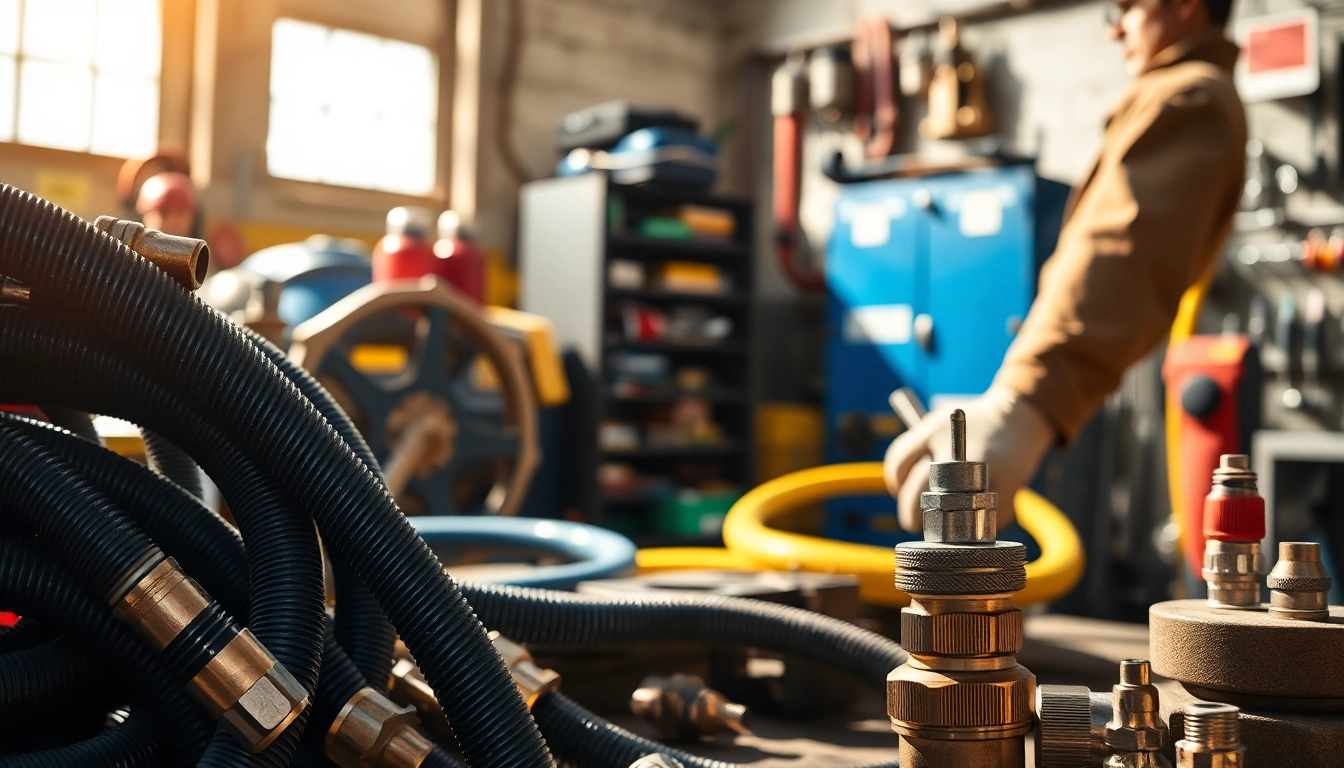
Understanding Air Hoses and Fittings
What Are Air Hoses and Fittings?
Air hoses and fittings are essential components used in various pneumatic systems. Air hoses are flexible tubes designed to transport compressed air from a source, such as an air compressor, to pneumatic tools and other equipment. Fittings, on the other hand, are the connectors that secure the hoses to the air compressor or tool, ensuring a tight and leak-free connection. Proper selection and usage of air hoses and fittings can greatly enhance the efficiency and safety of any pneumatic system.
Types of Air Hoses: Rubber, PVC, and Polyurethane
Air hoses come in several materials, each providing different benefits and drawbacks, which makes selecting the right type for your application crucial. Here’s a detailed comparison:
- Rubber: Known for its excellent flexibility and durability, rubber hoses can withstand high pressures and extreme temperatures. They are resistant to abrasions and kinks, making them ideal for industrial applications.
- PVC: Light and cost-effective, PVC hoses are less durable than rubber but are resistant to corrosion and mildew. They are perfect for light-duty applications, including home use and small workshops.
- Polyurethane: Polyurethane hoses are noted for their lightweight and flexibility. They are also more resistant to kinking than rubber, but they can be less durable when exposed to high temperatures and chemicals.
How to Choose the Right Air Hose for Your Needs
When selecting an air hose, consider the following factors:
- Application: Determine whether the hose will be used in light, medium, or heavy-duty tasks.
- Size: The diameter of the hose should match the output of the air compressor. Common diameters include 1/4 inch and 3/8 inch for most applications.
- Length: Choose a hose long enough to reach your equipment without putting undue tension on it.
- Temperature and Pressure Rating: Ensure the hose can handle the temperature and pressure it will be subjected to in use.
Key Features of Air Hoses
Flexibility and Durability in Air Hoses
The flexibility of an air hose is critical for ease of use. Hoses that are too rigid can be difficult to manage and prone to kinking or breaking. Durability is equally important; hoses should withstand wear and tear from regular use, environmental conditions, and the specific tasks they are employed in. High-quality air hoses are designed to maintain their integrity over extended periods, ensuring reliability.
Importance of Size and Connection Types
Selecting the correct size for your air hose is vital to ensure optimal airflow and pressure. A hose that is too small can restrict airflow, while one that is too large may lead to increased pressure loss. Connection types are equally important; common styles include threaded connections, push-to-connect, and quick-disconnect fittings. Each has its pros and cons, affecting performance based on the specific application.
Best Practices for Air Hose Maintenance
To extend the lifespan of your air hoses and ensure safety, consider these maintenance tips:
- Regularly inspect hoses for wear, leaks, or damage.
- Store hoses properly when not in use, preferably coiled without twists or kinks.
- Keep fittings clean and lubricated to prevent rust and facilitate easier connections.
- Avoid dragging hoses across rough surfaces to minimize abrasion.
Air Fitting Variations Explained
Common Types of Air Fittings and Their Uses
Air fittings play a crucial role in connecting hoses to tools and compressors. Here’s a breakdown of common types:
- Quick Disconnects: These allow for fast and easy changes between hoses and tools, increasing efficiency. The downside is that they can wear out over time.
- Threaded Fittings: These provide a secure and permanent connection, but they require tools to attach or detach, which may slow down efficiency.
- Push-to-Connect: These fittings facilitate quick connections without tools, offering a user-friendly option for frequent changes.
Choosing the Right Fitting for Your Applications
When choosing fittings, consider the following:
- Compatibility with hoses and tools.
- Pressure rating to match the system’s requirements.
- Frequency of connection/disconnection; quick disconnect styles are beneficial for high-frequency scenarios.
Understanding Quick Connect vs. Threaded Fittings
Both quick connect and threaded fittings have their unique advantages:
- Quick Connect: Ideal for dynamic work environments where tools need to be swapped often. They allow for rapid changes and reduce downtime.
- Threaded Fittings: Offer a more permanent solution and are often better for higher-pressure applications.
Installation and Usage Tips
How to Properly Install Air Hoses and Fittings
Correct installation is paramount for optimal performance and safety:
- Ensure that both hose and fitting are clean without debris.
- Install fittings hand-tight, followed by an additional quarter turn with a wrench for secure connections.
- Always inspect connections visually for leaks before operating your system.
Safety Measures When Using Air Tools
Using air tools safely involves understanding their operation and the environment in which they are used. Always wear appropriate personal protective equipment (PPE), ensure that the workspace is free of obstacles, and be familiar with the tools’ operating procedures. Moreover, maintain consistent pressure within the recommended limits and avoid direct line-of-sight to the hose, especially during operation.
Common Mistakes to Avoid with Air Hose Setup
To ensure safe and effective use of air hoses, consider the following common pitfalls:
- Using mismatched fittings can lead to leaks and pressure drops.
- Avoiding regular inspections can result in undetected wear and potential safety hazards.
- Failing to secure hoses properly might result in accidental disconnections or damage.
Where to Buy Quality Air Hoses and Fittings
Top Retailers for Air Hoses and Fittings
When shopping for air hoses and fittings, options range from local tool suppliers to larger online retailers. Some reliable places include:
- Local hardware stores
- Online retailers like air hoses and fittings suppliers
- Specialty tool shops that provide a range of pneumatic accessories
Online vs. In-Store Purchasing Considerations
Choosing between online and in-store purchasing comes down to convenience versus personal service:
- Online: Provides convenience and often a larger selection. However, it’s crucial to verify dimensions and specifications since you can’t physically inspect items before purchase.
- In-Store: Allows for immediate acquisition of needed items and expert advice from staff but may have a limited selection compared to online options.
Finding the Best Deals on Air Hoses and Fittings
To secure the best deals on air hoses and fittings:
- Monitor seasonal sales or discounts from major retailers.
- Sign up for newsletters from suppliers to receive special offers and promotions.
- Consider bulk purchasing or kits that may provide savings over individual items.






